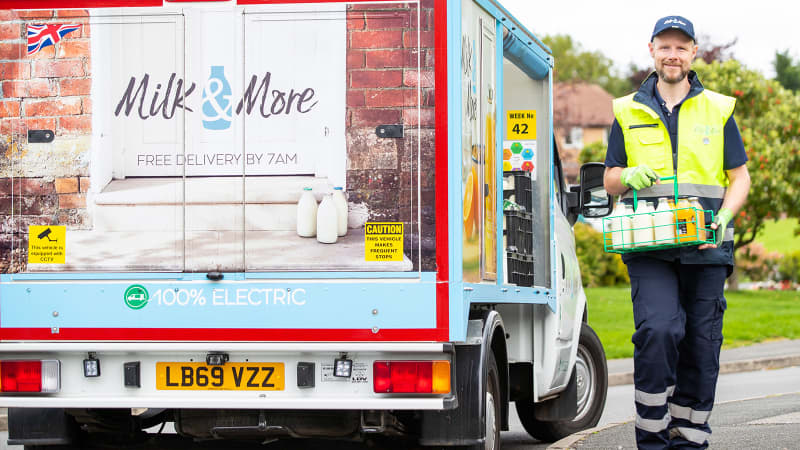Milking It: Milk & More Reduces Fleet Costs by £2m After Electrifying Fleet

Milk & More electric float. Source: Milk & More
Online artisan grocery delivery store Milk & More has put the potential cost-saving benefits of EVs into perspective after they announced that transitioning their entire fleet to electric vehicles has saved the company £2 million annually so far.
Milk & More’s fleet previously consisted entirely of diesel vehicles, most of which operated throughout the last mile of delivery to the consumer. Following the transition, Milk & More now boasts a 500-strong fleet of electric vehicles consisting of StreetScooters as well as a number of LDV (Maxus) EV80 vans. The fleet collectively travels over 10 million miles per year.
Telematics data has disclosed that the transition to EVs has had a significant impact on the companies fuel expenditure, saving the company around £2 million in annual fuel costs after cutting 1.8 million litres of annual diesel consumption from their fleet and subsequently 4,920 tonnes of CO2 emissions.
Patrick Müller, CEO of Milk & More, reaffirmed their commitment to going green: “Investing in our delivery vehicles is just one of the ways we are helping our customers play their part in looking after the planet. From working with suppliers who care as much about being sustainable as we do to reducing the amount of plastic we use, we’re proud to say that 80% of our products are sold in Zero Waste packaging that we collect, clean, and reuse.”
UK Ranks Fifth Among World’s Top 5 Major Markets for EV Readiness According to EY Report
![]()
According to EY’s EV Country Readiness Index (ECRI), the UK is ranked as the fifth best-prepared nation for transitioning to electric vehicles out of the world’s top twenty markets, maintaining last year’s ranking.
The EV Country Readiness Index includes both battery electric vehicles and plug-in-hybrids in their assessment and analyses twenty key markets from around the world based on factors related to supply, demand, and regulation, including alternative drivetrain initiatives, targets, and both long-term and short-term EV adoption strategies.
China has retained its position at the top of the Index, as they continue to dominate the EV supply chain while maintaining generous subsidies and a rigorous charging infrastructure. Norway, meanwhile, has retained second place and the US has made significant ground after advancing four places to third at the expense of Sweden, which moved down a place to fourth.
Maria Bengtsson, UK electric vehicle lead at EY, said: “It’s encouraging that the UK remains one of the frontrunners in pursuit of an effective transition towards EV adoption, but there is still scope for significant improvement.
“As the clear global leader according to the Index, China has demonstrated the impact that appropriate regulation along with a localised supply chain and robust infrastructure implementation can have.
“There are lessons to be learned from that for the UK market, and the onus will continue to be on OEMs and the government to collaborate on this challenge.”
It will be interesting to see what effect the UK Government’s recent delay on the banning of new petrol and diesel vehicles being sold by five years until 2035, alongside other watered-down net zero commitments, will have on the UK’s ECRI and subsequent ranking.
New Open-source Amazon Tool Determines Priority Locations for Deploying EV Charging Stations
Retail behemoth Amazon has unveiled a new open-source tool to help identify strategic and priority locations where electric charging stations should be constructed in order to accelerate EV preparedness in the logistics industry.
The open-source tool dubbed CHALET – Charging Locations for Electric Trucks – will aid in the implementation of public charging infrastructure and accelerate the transition to alternative drivetrain vehicles by solving pressing issues pertaining to the industry’s decarbonisation efforts.
The tool is openly accessible to private industries, governments, electricity network operators, and local authorities and generates a list of optimum charging locations ranked by priority. CHALET, which has been developed by Amazon over the past eighteen months, recommends locations taking into account specific factors such as vehicle battery, range, and transit time, and all industry stakeholders can benefit from its use.
“Middle-mile electrification in Europe will not scale until efficient and convenient charging infrastructure is put in place,” said Andreas Marschner, Vice President, Amazon Transportation Services. “Our teams have built an effective, science-based tool, and we’re open-sourcing the code to help all companies, big and small, make more strategic electrification decisions.”
GoCompare Release EV Charging Cost Tool

Ever wondered how much it actually costs to charge an electric vehicle? GoCompare has released an EV charging cost calculator to guide consumers and logistics stakeholders as to how much they will have to pay to fuel their EV, so businesses in particular can factor this into any investment decisions.
The calculator allows the public to choose a number of variables, such as the vehicle make, model, and trim, as well as the type of charging power output and charge cost per kWh, in order to calculate how much it will cost to charge a specific vehicle.
The cost calculator also includes a range of supportive content aimed at educating the public on charging costs, including information and advice on home charging and its effect on home electricity bills and the disparity in cost of using public charging versus home charging.
Data taken from the Energy Savings Trust, for example, outlines that it costs over double in terms of the cost per mile to charge an EV at home in comparison to a public charge point, showing a clear disparity in the pricing. Home charging does, however, require the installation of the charging infrastructure, which needs to be taken into account too.

The data also adds context to the price difference between the cost per mile to fuel an EV and a petrol-powered car: it costs 57% less per mile to charge an EV at home than it does to fuel a petrol-powered car.
This ultimately highlights the cost-saving benefits of transitioning to EVs, particularly if home charging is used, while dispelling charging myths and misconceptions through factual information.
Use the cost calculator here >>
Number of Vans on British Roads Hits Record High

In wider logistics news, new vehicle licencing data published by the government, which has subsequently been analysed by Direct Line, has disclosed that the number of light commercial vehicles (LCVs) active on British roads nearly totalled 4.5 million (4,485,31) at the end of 2022 – a record since data started being collected in 1994. This is a significant increase since 2021 -1,204,696 more light commercial vehicles, to be exact – which represents a 37% increase.
The average age of vans on British roads also continues to increase as the manufacturing quality of the vehicles and supportive vehicle care improves. The average age of vans on the road is now at 8.9 years – a record high since 1994 and up from 7.7 years old in 2012 (15.6% increase), which is a key factor as to why there are more vans on the road than ever before.
Malkit Sihra, van product manager at Direct Line business insurance, weighed in on the data: “On the one hand, a record number of vans on the road speaks to a promising amount of commercial activity across the country. On the other hand, the increase in the average age of vans on Britain’s roads points to an ongoing challenge for suppliers and buyers.
“With new van registrations only recently picking up after a prolonged slump, supply chain issues have driven van prices up across the board. Van drivers and fleets may be choosing to hold onto their LCVs for longer than initially planned as a result.”








